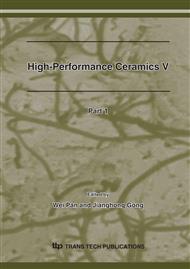p.503
p.507
p.510
p.514
p.517
p.521
p.524
p.526
p.529
Investigation of Electron Traps in SnO2 Based Varistor Ceramics
Abstract:
Dense tin oxide based ceramics are a new type of varistor materials. To further understand the electrical properties of SnO2 varistors doped with CoO, Nb2O5, and Cr2O3, the techniques of capacitancevoltage (C-V) measurement and deep level transient spectroscopy (DLTS) were used to investigate the electron traps in the SCN samples (doped with 1.0 mol% CoO and 0.05mol% Nb2O5) and SCNCr samples (doped with 1.0 mol% CoO, 0.05mol% Nb2O5 and 0.05mol% Cr2O3). Two electron traps were detected: trap T1 is located at Ec - 0.30 ± 0.01eV and trap T2 is located at Ec – 0.69 ± 0.03eV for both SCN and SCNCr samples. The variations in the donor density and trap density could be related to the addition of chromium oxide. The features of these traps are discussed based on the defect theory related to the SnO2 varistors.
Info:
Periodical:
Pages:
517-520
Citation:
Online since:
February 2008
Authors:
Keywords:
Price:
Сopyright:
© 2008 Trans Tech Publications Ltd. All Rights Reserved
Share:
Citation:


